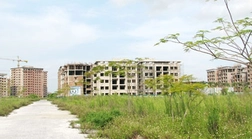According to the draft, in case a household or individual is recognized by the State for the right to use residential land, it is allowed to change the land use purpose from non-residential land to residential land for an area of residential land exceeding limit, the coefficient k is 1 times the land price announced by the People’s Committee of Ho Chi Minh City.
The land use levy that people pay to the state for conversion of land use purposes will be equal to the land price set by the City People’s Committee multiplied by this k coefficient.
Previously, according to the previous regulations in Decision No. 18/2013/QD-UBND dated May 30, 2013, households and individuals would be applied a k coefficient of 1.1 to 2 times the price land, when calculating land use fees. Specifically, the highest k coefficient is 2 times in central districts such as 1,3,4,5… and the lowest is 1.1 times in Can Gio district. Thus, compared with the current regulations, the land price adjustment coefficient for households and individuals has been significantly reduced.
The reason, thousands of housing documents in HCMC are blocked because of the land price list announced and applied by the city since January 1, 2015, but the land price adjustment coefficient has not been officially announced yet. .
According to the 2015 land price list, the average land price has increased 1.28-1.99 times compared to the 2014 land price list and equal to about 23-30% of the actual market price.
During the preparation of the draft Decision on the land price adjustment coefficient in 2015, the Department of Finance and Natural Resources – Environment of Ho Chi Minh City proposed to the People’s Committee of Ho Chi Minh City to approve the new k coefficient equivalent to the new system. The number of k previously issued depends on the area and the ratio of the 2015 land price list to the market price.
Thus, through many times of receiving and editing the draft, the People’s Committee has given the coefficient k applied to the case of households and individuals as 1 time as above. This is expected to help people soon fulfill their financial obligations to the State, and at the same time get a certificate of residential land use rights soon.
K-factor by area
Also according to the draft Decision above, for objects in groups 2 and 3 (see below), the coefficient k will change in each area.
Specifically, this draft divides Ho Chi Minh City into 5 areas including (i) area 1 including districts 1, 3, 4, 5, 10, 11, Tan Binh, Phu Nhuan; (ii) zone 2 includes districts 6, 7, Go Vap, Binh Thanh and Tan Phu; (iii) zone 3 includes districts 2, 8, 9, 12, Binh Tan, Thu Duc; (iv) Area 4 includes Binh Chanh, Cu Chi, Nha Be and Hoc Mon districts; and (v) area 5 including Can Gio district.
For group 2, which is the case when determining the annual land rental unit price for the first stabilization period or when there is a adjustment of the land rental unit price for the next stabilization period, the starting price in auction of land use rights for lease in the form of land lease with annual land rental payment, the land rental unit price upon receipt of the transfer of land-attached assets specified in Clause 3, Article 189 of the Land Law, the system number k is applied depending on land use and area.
Specifically, for the purpose of using leased land for service business, commerce, finance, restaurants, hotels, houses for rent, offices for rent, etc., the coefficient k is from the area respectively. 1 to zone 5 is 2; 1.8; 1.6; 1.4; and 1.2 times.
For the purpose of industrial production, handicrafts, warehouses, factories, land to build supermarkets, commercial stores with stable sales, petrol stations, ports, piers, bus stations, airport, agro-forestry production, etc., the k coefficient from area 1 to area 5 is 1.2, respectively; 1.1; 1.05; first; and 1 time.
Group 3 is the cases where the organization is allocated land by the State with the collection of land use levy not through the form of auction of land use rights, recognition of land use rights, or permission to change the land use purpose; households and individuals allocated land by the State without auctioning land use rights; determine the land rental unit price paid once for the entire lease period not through auction; determine the land rental unit price when changing from land lease with annual payment to land lease with one-off payment of land rental for the entire lease period as prescribed in Clause 2, Article 172 of the Land Law; determine the land rental unit price paid once for the entire lease period when equitizing state-owned enterprises.
The coefficient k applied to group 3 from area 1 to area 5 is 2, respectively; 1.8; 1.6; 1.4, and 1.2 times.




